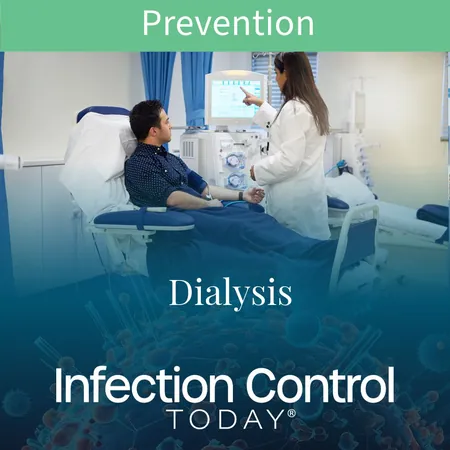
The Hidden Dangers: Infection Risks for Dialysis Patients That You Didn't Know About!
2025-04-03
Author: Yu
In the realm of healthcare, the plight of immunocompromised patients is often overshadowed by more visible issues. But lurking beneath the surface is a silent epidemic—an infection crisis that predominantly affects individuals undergoing dialysis. These patients, beset by multiple health challenges such as end-stage kidney disease (ESKD), diabetes, and heart disease, find themselves in a perilous position. The invasive nature of dialysis further complicates matters, as it necessitates access to the vascular system or peritoneal cavity, making them susceptible to infections that healthy individuals typically fend off with ease.
Startling Statistics on Dialysis and Infections
Patients undergoing hemodialysis (HD) are at a dramatic risk of life-threatening infections. A staggering 70% of bloodstream infections in this demographic are attributed to central venous catheters (CVCs), making infectious complications the second leading cause of death among these patients, right after cardiovascular diseases. Alarmingly, shortcomings in infection control—often stemming from lapses in staff education regarding hand hygiene and equipment sterilization—have been linked to outbreaks of bloodstream infections and even hepatitis C (HCV).
The Multifaceted Nature of Infection Control
The task of infection prevention in dialysis units requires unwavering commitment and the implementation of stringent protocols. Nephrologists must become champions of infection control, rallying their teams to adhere meticulously to established guidelines. But the reality is stark: the roadblocks are numerous. Immunocompromised patients face frequent hospitalizations and heightened vulnerability due to underlying conditions—setting the stage for recurrent infections and the emergence of antibiotic-resistant bacteria like methicillin-resistant Staphylococcus aureus (MRSA).
Effective Strategies for Prevention
To combat the pressing infection rates among dialysis patients, a multi-pronged strategy is vital: 1. **Robust Implementation of Standard Precautions**: The cornerstone of infection prevention is effective hand hygiene and environmental disinfection. Dialysis centers should ensure that every chair or bed is equipped with handwashing facilities and alcohol-based hand rubs. 2. **Transmission-Based Precautions**: Dialysis units must promptly instate additional precautions when dealing with patients known to harbor resistant bacterial strains. This includes proper screening protocols. 3. **Aseptic Technique**: The use of standard supplies should be minimized, favoring single-use items to diminish the risk of contamination. 4. **Thorough Cleaning Procedures**: Rigorous cleaning of dialysis stations after each session is non-negotiable, focusing on frequently touched surfaces and equipment. 5. **Vaccination Protocols**: Annual flu shots and routine hepatitis B vaccinations are critical for patients and staff alike. Furthermore, other vaccinations for diseases like pneumococcal pneumonia and shingles should not be overlooked. 6. **Protecting Against Bloodborne Viruses (BBVs)**: Stringent adherence to hygiene practices can dramatically lessen the risk of BBV transmission. Dedicated rooms and equipment for infected patients are imperative. 7. **Minimization of Vascular Access Infections**: Use arteriovenous (AV) fistulas whenever possible instead of central lines, and instill a culture of daily care for access sites among patients. 8. **Infection Surveillance**: Continuous monitoring of infection rates is vital for understanding trends and improving practices in dialysis centers.
A Call to Action
The rates of severe infections among dialysis patients remain alarmingly high due to insufficient infection control practices. The urgency to refine these practices cannot be overstated. Nephrology leaders must take charge and ensure that every individual involved in the care of dialysis patients is fully aware and compliant with infection control protocols. With concerted efforts, it's possible to envision a future devoid of preventable infections, enhancing the quality of life for one of the most vulnerable patient populations. Stay informed and alert—for the fight against infections in dialysis patients is a silent battle that desperately needs our attention!


 Brasil (PT)
Brasil (PT)
 Canada (EN)
Canada (EN)
 Chile (ES)
Chile (ES)
 Česko (CS)
Česko (CS)
 대한민국 (KO)
대한민국 (KO)
 España (ES)
España (ES)
 France (FR)
France (FR)
 Hong Kong (EN)
Hong Kong (EN)
 Italia (IT)
Italia (IT)
 日本 (JA)
日本 (JA)
 Magyarország (HU)
Magyarország (HU)
 Norge (NO)
Norge (NO)
 Polska (PL)
Polska (PL)
 Schweiz (DE)
Schweiz (DE)
 Singapore (EN)
Singapore (EN)
 Sverige (SV)
Sverige (SV)
 Suomi (FI)
Suomi (FI)
 Türkiye (TR)
Türkiye (TR)
 الإمارات العربية المتحدة (AR)
الإمارات العربية المتحدة (AR)